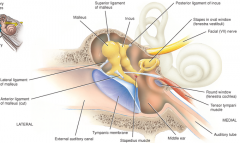![]()
![]()
![]()
Use LEFT and RIGHT arrow keys to navigate between flashcards;
Use UP and DOWN arrow keys to flip the card;
H to show hint;
A reads text to speech;
10 Cards in this Set
- Front
- Back
|
Two types of astrocytes |
1. Protoplasmic astrocyte - short branching processes and are found in gray matter 2. Fibrous astrocyte - long unbranched processes located in white matter |
|
|
Ligand gated channels |
The neurotransmitter acetylcholine, for example, opens cation channels that allow Na+ and Ca2+ to diffuse inward and K+ to diffuse outward |
|
|
What do the: Axillary Musculocutaneous Radial Medican Ulnar nerve service |
Axillary: deltods, teres minor Musculocutaneous: anterior arm Radial: Posterior arm, forearm Median: anterior forearm Ulnar: anteriormedial forearm and most of hand |
|
|
! |
1) the external ear, which collects sound waves and channels them inward; (2) the middle ear, which conveys sound vibrations to the oval window; and (3) the internal ear, which houses the receptors for hearing and equilibrium. |
|
|
! |
The external (outer) ear consists of the auricle, external auditory canal, and eardrum |
|
|
! |
tympanic membrane (tim‐PAN‐ik; tympan‐ = a drum) or eardrum is a thin, semitransparent partition between the external auditory canal and middle ear. The tympanic membrane is covered by epidermis and lined by simple cuboidal epithelium |
|

|
alleus, incus, and stapes—commonly called the hammer, anvil, and stirrup, he “handle” of the malleus (MAL‐ē‐us) attaches to the internal surface of the tympanic membrane. The head of the malleus articulates with the body of the incus. The incus (ING‐kus), the middle bone in the series, articulates with the head of the stapes. The base or footplate of the stapes (STĀ‐pēz) fits into the oval window. Directly below the oval window is another opening, the round window, which is enclosed by a membrane called the secondary tympanic membrane. oval window fenestra vestibuli round window fenestra cochlea |
|
|
! |
The anterior wall of the middle ear contains an opening that leads directly into the auditory (pharyngotympanic) tube, commonly known as the eustachian tube(ū′‐STĀ‐kē‐an, ū‐STĀ‐shun). |
|
|
! |
(1) the semicircular canals, (2) the vestibule, and (3) the cochlea. |
|
|
! |
Sections through the cochlea reveal that it is divided into three channels: cochlear duct, scala vestibuli, and scala tympan |

